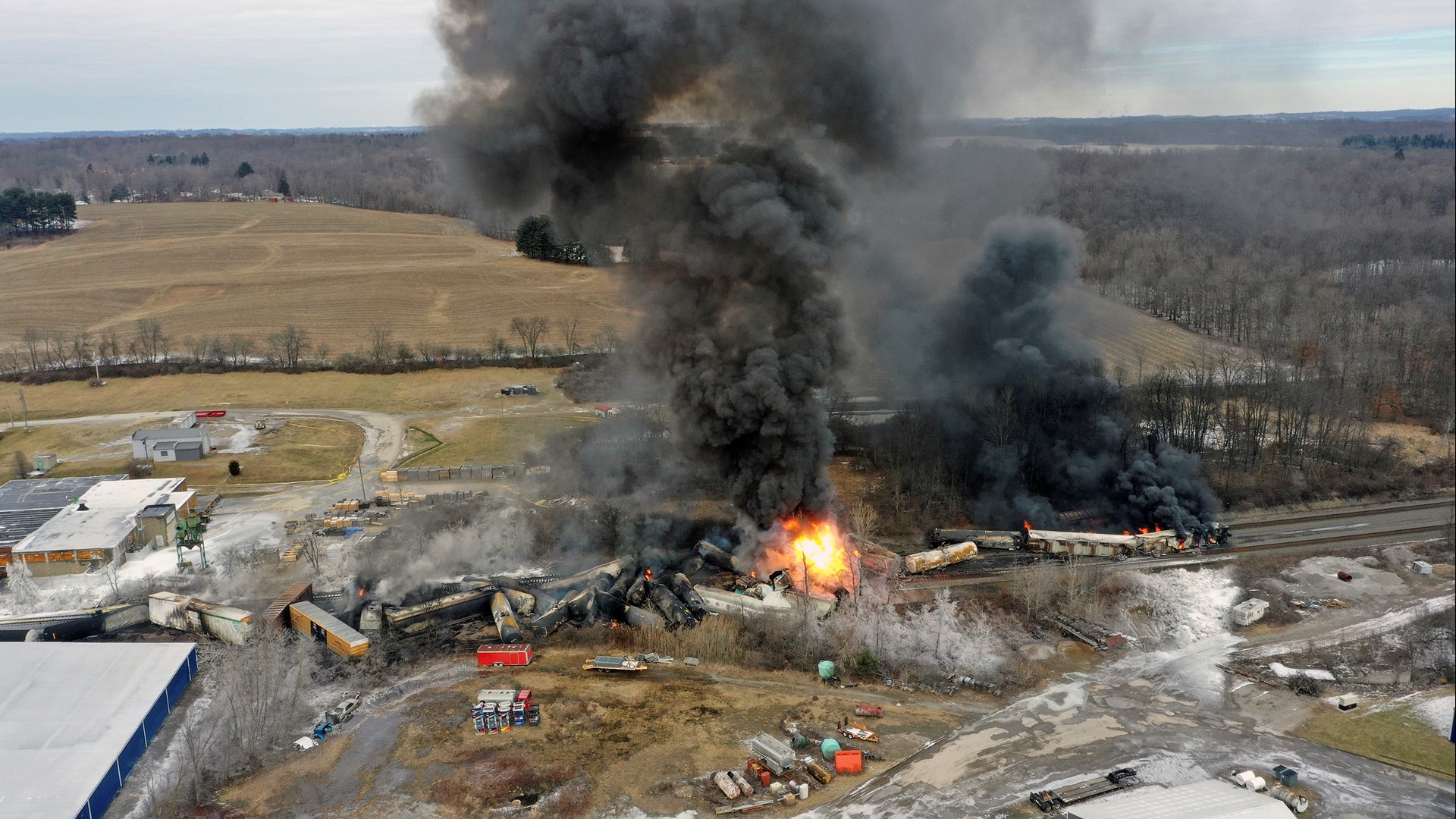Months-Long Contamination: Toxic Chemical Residue From Ohio Train Disaster

Table of Contents
The Initial Disaster and Immediate Aftermath
On February 3, 2023, a Norfolk Southern freight train carrying hazardous materials derailed in East Palestine, Ohio. The immediate aftermath involved a controlled burn of vinyl chloride, a decision that, while intended to prevent a potentially larger explosion, released toxic fumes into the air, raising immediate concerns about air pollution and potential health impacts. The initial evacuation zone encompassed a significant area around the derailment site.
- Number of cars derailed: Approximately 50
- Initial evacuation zone size: 1-2 mile radius
- Controlled burn and its implications: Released phosgene and hydrogen chloride into the air, causing concerns about respiratory issues.
- Immediate health concerns reported by residents: Reports of headaches, nausea, eye irritation, and respiratory problems emerged immediately following the derailment and controlled burn. The release of vinyl chloride, known for its carcinogenic properties, added another layer of concern. Other chemicals released, including butyl acrylate, ethylene glycol monobutyl ether, and ethylhexyl acrylate, further compounded the health risks.
Ongoing Environmental Contamination
The environmental impact of the Ohio train derailment extends far beyond the immediate aftermath. Widespread contamination of soil, water, and air continues to pose significant long-term challenges.
Soil Contamination
The extent of soil contamination remains a primary concern. Testing methods employed by various agencies are still underway, but initial findings indicate widespread presence of toxic chemicals in the soil.
- Testing methods used: Soil samples are being analyzed for the presence of various contaminants, including vinyl chloride and other hazardous materials.
- Areas affected: Residential areas, agricultural lands, and nearby waterways have all been affected. The long-term impact on agricultural productivity and ecosystem health is still being assessed.
- Long-term effects on soil fertility and ecosystem health: The presence of toxic chemicals can severely impair soil fertility, impacting plant growth and potentially harming the overall health of the ecosystem. Bioremediation efforts are crucial to address this.
Water Contamination
Concerns about water contamination are equally pressing. Local water sources, including wells and the Ohio River, are being closely monitored.
- Testing results for contaminants: Ongoing testing is revealing the presence of various contaminants in water samples.
- Potential long-term effects on drinking water safety: The long-term implications for drinking water safety in the region remain a significant worry. Continuous monitoring and potentially costly water treatment solutions are necessary to ensure public safety.
- Impact on aquatic life: The release of toxic chemicals into waterways poses a serious threat to aquatic life, potentially leading to significant ecological damage.
Air Pollution
The controlled burn released a plume of toxic pollutants into the atmosphere, impacting air quality in the surrounding area. While the immediate, acute effects may have subsided, the long-term consequences of air pollution remain unclear.
- Types of pollutants released into the air: Vinyl chloride, hydrogen chloride, and other toxic substances were released into the atmosphere.
- Monitoring of air quality: Ongoing monitoring of air quality is necessary to assess the long-term impacts on respiratory health.
- Respiratory illnesses reported in the affected area: Reports of increased respiratory illnesses, including coughing, wheezing, and shortness of breath, are cause for concern and require further investigation.
Long-Term Health Concerns and Community Impact
The potential long-term health effects associated with exposure to the released chemicals are deeply concerning. The community is facing a multitude of challenges, both physical and psychological.
- Reported health issues: Residents are reporting a range of health issues, including respiratory problems, headaches, nausea, and skin irritations. Long-term studies are needed to fully understand the health consequences.
- Mental health challenges faced by residents: The stress and uncertainty surrounding the disaster have led to significant mental health challenges for many residents.
- Impact on local businesses and the economy: The derailment has had a devastating economic impact on the community, affecting local businesses and tourism.
- Community activism and advocacy efforts: Residents have shown remarkable resilience and are actively advocating for greater accountability and more comprehensive cleanup efforts.
Government Response and Cleanup Efforts
The government's response to the disaster has been met with criticism from some residents and environmental advocates. Cleanup efforts are ongoing, but their effectiveness and long-term success are yet to be determined.
- Federal and state agencies involved: The EPA, FEMA, and various state agencies are involved in the response and cleanup efforts.
- Funding allocated for cleanup and health monitoring: Significant funding has been allocated, but its adequacy is being debated.
- Effectiveness of cleanup strategies: The effectiveness of the ongoing cleanup strategies needs to be rigorously assessed and transparently communicated to the public.
- Transparency of information released to the public: Concerns remain about the transparency of information provided to the public regarding the extent of contamination and the potential health risks.
Conclusion
The Ohio train derailment represents a significant environmental disaster with far-reaching consequences. The months-long contamination from toxic chemical residue poses a persistent threat to the health and well-being of the affected community and the environment. Comprehensive cleanup and long-term health monitoring are critical to mitigate further risks. We must address the lingering threat of toxic chemical residue, demand a thorough investigation of the Ohio train derailment, and ensure a comprehensive cleanup of the Ohio train disaster site. Continued vigilance, advocacy, and accountability are essential to protect the community and prevent similar disasters in the future.

Featured Posts
-
 Mining Meaning From Mundane Data An Ai Approach To Creating A Poop Podcast
May 01, 2025
Mining Meaning From Mundane Data An Ai Approach To Creating A Poop Podcast
May 01, 2025 -
 Lempron Tzeims O Basilias Ftanei Toys 50 000 Pontoys
May 01, 2025
Lempron Tzeims O Basilias Ftanei Toys 50 000 Pontoys
May 01, 2025 -
 Federal Investigation Office365 Data Breach Leads To Multi Million Dollar Loss
May 01, 2025
Federal Investigation Office365 Data Breach Leads To Multi Million Dollar Loss
May 01, 2025 -
 Malek F Steekt Patient Neer In Van Mesdagkliniek Groningen Details En Achtergrond
May 01, 2025
Malek F Steekt Patient Neer In Van Mesdagkliniek Groningen Details En Achtergrond
May 01, 2025 -
 Army Chyf Ka Byan Bhart Ky Kshmyr Palysy Ka Jayzh
May 01, 2025
Army Chyf Ka Byan Bhart Ky Kshmyr Palysy Ka Jayzh
May 01, 2025
Latest Posts
-
 Vaticano Condanna Becciu Dettagli Sul Risarcimento Agli Accusatori
May 01, 2025
Vaticano Condanna Becciu Dettagli Sul Risarcimento Agli Accusatori
May 01, 2025 -
 Processo Becciu Appello 22 Settembre Ricerca Della Giustizia
May 01, 2025
Processo Becciu Appello 22 Settembre Ricerca Della Giustizia
May 01, 2025 -
 Becciu Il 22 Settembre Inizia L Appello La Sua Dichiarazione Di Innocenza
May 01, 2025
Becciu Il 22 Settembre Inizia L Appello La Sua Dichiarazione Di Innocenza
May 01, 2025 -
 Il Cardinale Becciu Risponde Analisi Delle Chat Segrete E Del Processo
May 01, 2025
Il Cardinale Becciu Risponde Analisi Delle Chat Segrete E Del Processo
May 01, 2025 -
 Processo Becciu Data Appello 22 Settembre Aspettando La Verita
May 01, 2025
Processo Becciu Data Appello 22 Settembre Aspettando La Verita
May 01, 2025
